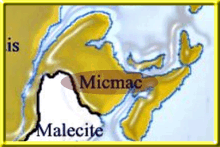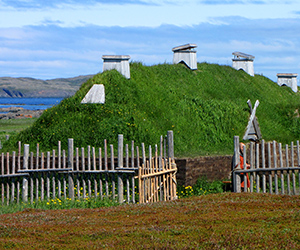CANADA HISTORY
Kwakiutl

The Kwakiutl people are a indigenous tribe from the Pacific Northwest coast of North America, specifically present-day British Columbia, Canada. Before European contact, the Kwakiutl people had a rich and complex culture, with a sophisticated social structure, a complex mythology and religious beliefs, and a thriving artistic tradition.
The Indigenous peoples of the Pacific Northwest, including the Kwakiutl, are believed to have originally migrated to the region from Asia. According to the theories of the first peoples of the Pacific Northwest, the Indigenous peoples of the region are descendants of people who migrated to the area from Asia thousands of years ago.
The exact details of the migration are not well documented, but it is believed that the first peoples of the Pacific Northwest traveled across the Bering Strait land bridge that once connected Asia and North America during the last ice age. Over time, these migrants developed unique cultures, languages, and traditions that were shaped by the rich and diverse environments of the Pacific Northwest.
The Kwakiutl lived in large, multi-family longhouses and were organized into matrilineal clans. They were skilled fishers, hunters, and traders and relied on the abundant resources of the ocean and forests for their livelihoods. They also had a well-developed system of governance, with a hereditary chiefdom system, and a complex social and political hierarchy.
The Kwakiutl were known for their elaborate potlatch ceremonies, where they would host feasts and gift-giving events to celebrate important events such as births, deaths, and marriages, as well as to demonstrate their wealth and status. These events were accompanied by dances, songs, and speeches, and were an important aspect of Kwakiutl culture.
The Kwakiutl people had a rich and complex mythology, which was reflected in their artwork and rituals. They carved masks, totems, and other objects from wood, depicting spiritual beings and animals. The Kwakiutl also had a tradition of oral storytelling, which passed down their cultural beliefs and history from generation to generation.
The Kwakiutl people had a complex and diverse religious belief system, centered around the worship of a pantheon of spirits and supernatural beings. They believed in a complex cosmology that included a variety of spiritual entities, including animal spirits, ancestral spirits, and supernatural beings, who could bring both good and bad luck.
One of the most important spiritual beings in Kwakiutl religion was the thunderbird, a powerful bird-like creature that was associated with thunder and lightning. The Kwakiutl believed that the thunderbird had the power to control the weather and could bring both good and bad luck to the tribe.
Ancestral spirits were also an important aspect of Kwakiutl religion. They believed that the spirits of their ancestors lived on after death and could continue to influence their lives. The Kwakiutl held annual memorial potlatches to honor their ancestors and keep their spirits appeased.
The Kwakiutl also believed in a variety of supernatural beings, such as the sisiutl, a two-headed serpent, and the kukwal, a shape-shifting sea monster. They performed rituals and dances to placate these beings and ensure the well-being of the tribe.
In addition to these beliefs, the Kwakiutl people also held spiritual beliefs centered around the power of the natural world, such as the power of the ocean and the forests. They believed that these elements had their own spirits and could bring both good and bad luck to the tribe.
The Kwakiutl's religious beliefs were deeply intertwined with their daily lives and informed many aspects of their culture, including their art, storytelling, and ceremonies. Despite the challenges they faced, the Kwakiutl people have managed to maintain many of their traditional religious beliefs and practices, and their spirituality continues to play an important role in their lives today.
The Kwakiutl people were heavily reliant on the resources of the Pacific Northwest coastal environment for their food and materials. They lived in a region abundant in fish, game, and forests, and their way of life was centered around these resources.
The Kwakiutl were skilled fishers and relied heavily on the ocean for their sustenance. They fished for a variety of species, including salmon, halibut, and herring, using nets, hooks, and weirs. Fishing was an important part of Kwakiutl culture, and the harvest of salmon, in particular, was celebrated with elaborate ceremonies and feasts.
In addition to fishing, the Kwakiutl were also skilled hunters, hunting deer, bear, and other game animals for food and materials. They also relied on the forests for a variety of resources, including wood for construction, bark for baskets and clothing, and berries and other plant foods for nutrition.
The Kwakiutl were also known for their intricate basketry, made from cedar bark and other materials. They used baskets for a variety of purposes, including storage, transportation, and as gifts during potlatches.
In summary, the Kwakiutl people relied on the abundant resources of the Pacific Northwest coastal environment for their food and materials. Fishing, hunting, and gathering were essential to their way of life and played a significant role in their culture and beliefs.
The Kwakiutl people had relationships with many other indigenous peoples in the Pacific Northwest region, both friendly and hostile. The region was home to a number of distinct indigenous cultures, and the Kwakiutl interacted with these groups in a variety of ways, including through trade, intermarriage, and conflict.
The Kwakiutl people were known for their trading networks, which extended throughout the Pacific Northwest and beyond. They traded with other indigenous groups for goods such as furs, shells, and food. These trade relationships were often accompanied by intermarriage and other forms of cultural exchange, which helped to foster relationships between the different tribes.
However, not all of the Kwakiutl's relationships with other indigenous peoples were peaceful. The Pacific Northwest was a region of ongoing conflict, and the Kwakiutl were involved in a number of wars with neighboring tribes, often over access to resources or territory. These conflicts could be brutal and often resulted in significant loss of life and property.
Despite these challenges, the Kwakiutl maintained complex relationships with other indigenous peoples in the region, and their culture was shaped by these interactions. The exchange of goods, ideas, and cultural practices with other tribes helped to enrich Kwakiutl culture and made it a unique blend of different indigenous traditions.
Yes, the Kwakiutl people had a practice of slavery, although it was different from the institution of slavery as it was known in other parts of the world. Slaves in Kwakiutl society were primarily war captives taken in raids and battles with other tribes. These captives were often forced to work for their captors, and they were considered to be property rather than individuals with rights and freedoms.
In some cases, slaves were treated relatively well and were even allowed to earn their freedom, either through good behavior or by paying a ransom. However, in other cases, slaves were treated harshly and subjected to harsh conditions and abuse.
The institution of slavery was an important part of Kwakiutl society, and slaves were used for a variety of purposes, including as laborers, servants, and as objects of prestige. The number of slaves a person owned was considered a measure of wealth and status, and slaves were often given as gifts or traded during potlatches, a central part of Kwakiutl social and economic life.
The Kwakiutl people had their first contact with Europeans in the late 18th and early 19th centuries. The first recorded contact between the Kwakiutl and Europeans was in 1792, when British navigator George Vancouver encountered the Kwakiutl on his expedition to chart the Pacific Northwest coast.
In the following decades, the Kwakiutl encountered a growing number of European explorers, traders, and settlers as the Pacific Northwest was gradually colonized. These encounters had a profound impact on Kwakiutl society and culture, and the arrival of Europeans brought new technologies, diseases, and ways of life that challenged the traditional Kwakiutl way of life.
The Kwakiutl responded to this new cultural landscape in a variety of ways, ranging from resistance and avoidance to adaptation and integration. Despite these challenges, the Kwakiutl managed to maintain much of their cultural heritage and traditions, and their unique way of life continues to influence the region and the world today.
Some of the main events and dates in Kwakiutl history include:
Late 18th century: First contact with Europeans. The first recorded contact between the Kwakiutl and Europeans occurred in 1792 when British navigator George Vancouver encountered the Kwakiutl on his expedition to chart the Pacific Northwest coast.
Late 19th century: Smallpox epidemic. A smallpox epidemic swept through the Pacific Northwest in the late 19th century, decimating the Kwakiutl and other indigenous peoples in the region.
1849: Treaty of Fort Victoria. The Treaty of Fort Victoria was signed between the Kwakiutl and the British Crown, recognizing Kwakiutl territorial rights and granting them a reserve.
Late 19th and early 20th centuries: Potlatch ban. The Canadian government imposed a ban on the potlatch, a central part of Kwakiutl social and economic life, in an effort to assimilate the Kwakiutl into Canadian society. The ban was in effect from 1884 to 1951.
1927: Re-establishment of the potlatch. The Kwakiutl successfully petitioned the Canadian government to lift the ban on the potlatch, and the tradition was re-established in 1927.
1982: Constitution Act. The Canadian Constitution Act recognized the inherent rights of indigenous peoples and granted them constitutional protection. This act marked a turning point in the relationship between the Canadian government and the Kwakiutl, and other indigenous peoples in Canada.
Present day: Continued cultural preservation and revitalization. Today, the Kwakiutl people continue to work to preserve and revitalize their cultural heritage, and their traditions and practices continue to play a central role in Kwakiutl life and identity.

Cite Article : www.canadahistory.com/sections/documents




